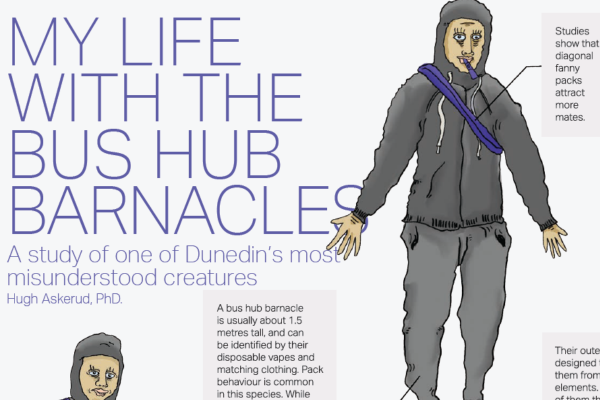A bus hub barnacle is usually about 1.5 metres tall, and can be identified by their disposable vapes and matching clothing. Pack behaviour is common in this species. While they are often regarded as dangerous, like so many other mid-sized mammals, their bark is worse than their bite.
You know them when you see them. Small, with steely eyes and shifty hands, the bus hub barnacle is one of the most feared species in the city. They travel in packs, able to ward off much larger predators, and apparently have no sense of fear as they operate directly outside of the local police station. But there is more to this animal than meets the eye. Critic Te Ārohi sent a young naturalist to observe the wild animals and, if they dared, try to get amongst their ranks.
“Can be violent and should not be approached” is a description of a bus hub barnacle given by a security guard who usually works in the area. For those unaccustomed to Dunedin’s cultural canvas, a bus hub barnacle can be identified as a teenager who loiters around the bus hub every afternoon, hoodie drawn up, disposable vape in hand. These creatures will often berate passing members of the public and exchange TikTok jargon with one another, much to the chagrin of the other bus-goers who have no choice but to listen in.
Aforementioned security guard Will* defined a bus hub barnacle as a “wannabe gang member, some of whom are very violent.” Ominously, Will also warned that while there were only 20-30 barnacles present, “they are out to recruit new members every day.” Don’t be fooled by their beguiling smiles, budding explorers; were this pack ever to ally with the local breatha population, it could spell the demise of the casual bus-goer.
Bus hub barnacles have been subject to intense scrutiny from media and police in recent years, largely due to the fact that their natural habitat is right outside the police station. But with so much negative attention, any good naturalist must consider if this group is truly deserving of their bad reputation. After all, as we’ve learned from hyenas, the most feared animals are often also the most intelligent.
Will mentioned that “some can be friendly”, but followed this up by saying that “they will keep asking you for drugs and alcohol, which gets very annoying.” To get a different perspective, I had a chat with Carey*, a year 12 student who frequents the bus hub after school when the group’s presence can be felt most prominently. Carey stated that she “would be ashamed” to be considered a bus hub barnacle. She followed this up by describing the pack as “a mix of people who have dropped out of school and their mates who are about to drop out”, so, in her words, “they’re not really defensible.”
What perplexed Carey the most was that the bus hub barnacles never seemed to go anywhere despite their convenient location. Perhaps this is an allegorical reflection of the group’s inability to take other opportunities in their lives. So, are the bus hub barnacles really as indefensible as Carey claims, or is your average barnacle something akin to a Shakespearean tragic protagonist, stuck in the land of opportunity yet unable to act?
To answer this pressing question I would need to be indoctrinated into the bus hub barnacle community, perhaps for life. Thus I entered the ranks of the community the only way I possibly could: by loitering in their ecosystem. Will had recommended carrying a weapon and wearing red to show my affiliation with the group. In turn, I adorned my finest Liverpool FC kit and carried the most powerful weapon of all, the written word, in order to make my presence obviously felt.
I approached the group’s habitat at around 3:24pm: peak barnacle hour. Instantly, I spotted the mass shuffling outside Farmers. While a core group of barnacles sat vaping, kissing, and shouting at one another, another group of older, drunken men had attached itself to the periphery of the group. After strolling aimlessly for five minutes, I plonked myself in between the two groups and waited for the mystery of the barnacle to unfold.
Listening to the half-conversations between members of the community, it occurred to me that the group could be defined by one core value: change. Conversations often dissolved under the weight of small attention spans as one barnacle amongst the ranks would get bored and make a gut-wrenching noise to draw a crowd. Additionally, the community always seemed to be on the move. Sitting then standing, hugging then kicking, you never knew what to expect. Half-horrified and half-entertained, the constant flux of behaviour was, for me, a sight to behold. As such, it shouldn’t then have come as a surprise when one member of the group proclaimed, “Our bus is here,” and the lot piled on. I had been scorned, rebuked, left behind. But that was okay, I didn’t want to be a part of their stupid club anyway. Not at all.
So I sat there, stunned by the realisation that the bus hub barnacles do actually catch buses. I began once again strolling around the ecosystem aimlessly. I peered up and down the row of seats before it dawned on me that I had outlasted the group I had feared for so long. Sitting down, I began hurriedly scribbling my observations in a notebook before glancing around and noticing a few wayward glances aimed in my direction.
Suddenly, the realisation hit me: in my endeavour to track the comings and goings of the bus hub barnacles I had, in a way, become another one of the strange oddities that the bus hub attracts. Oh, how the tables turn!



